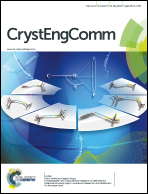Organic–inorganic hybrid assemblies based on Ti-substituted polyoxometalates for photocatalytic dye degradation†
Abstract
Two new organic–inorganic hybrid compounds, [N(CH3)4]6[CuIILo][(Ti2O)(PW11O39)2]·4H2O (1) and [N(CH3)4]2[H2bpp]2[CuIILo][(Ti2O)(PW11O39)2]·1.5H2O (2) (Lo = 1,2-bis(3-(2-pyridyl)pyrazole-1-ylmethyl)benzene, bpp = 1,3-bis(4-piperidyl)propane), based on Ti-substituted polyoxometalates (abbr. Ti-POMs) and the metal–organic linking units constructed by CuII ions and bichelate-bridging ligands (Lo), have been hydrothermally prepared. The two compounds were characterized by elemental analyses, IR spectra, TG analyses, XPS spectra, powder X-ray diffraction and single-crystal X-ray diffraction analyses. Both compounds contain a rare corner-sharing double-Keggin type POM architecture in the Ti-POM species. In 1 and 2, the double-Keggin-type polyoxoanions connect with the butterfly-type [CuIILo] units to form a 1-D chain and a square plane, respectively. The photocatalytic properties of compounds 1 and 2 were investigated with the methylene blue (MB) degradation model under UV irradiation, indicating good photocatalytic activity. Furthermore, to compare the photocatalytic properties of the Keggin-type Ti-POMs with those of traditional Keggin-type POMs, another compound [CuILo]4[PW12O40] (3) was synthesized by combining typical Keggin-type polyoxoanions with the metal–organic [CuILo] units. A series of MB degradation experiments suggest that the Ti-POMs exhibit better photocatalytic activity than typical Keggin-type saturated POM species.


 Please wait while we load your content...
Please wait while we load your content...